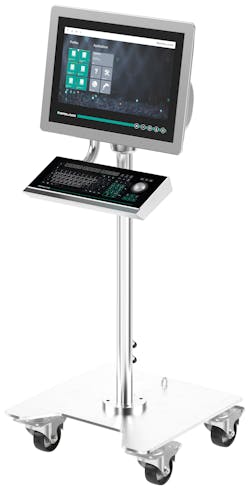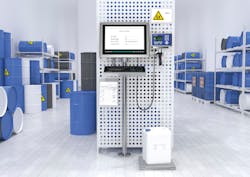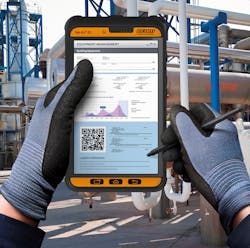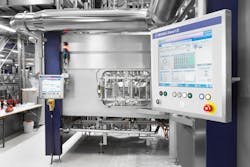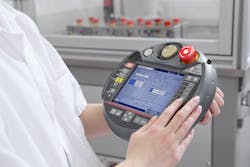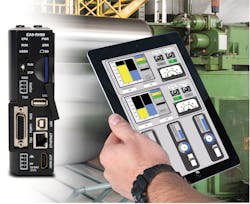A Control Design reader writes: I’ve worked in industrial machine building since before the introduction of the Internet, when machine operator controls were a switch or a pushbutton. Now, our human-machine interfaces (HMIs) control whole systems, visualize how we interact with the machines and collect data for further analysis. Our company has adopted rapidly to new HMI technology, as long as it remains cabinet-mounted. We’ve yet to try any new options for operator interfaces, such as wireless devices, cable-connect HMI pads or HMIs on a swivel arm. We do still have remote access via our cabinet-mounted HMIs, but what might some of these newer options offer that we’re missing out on? What other options are available? How do we weigh them against traditional HMI?
Answers
Installation flexibility moves HMIs outside of the cabinet
There are all sorts of variants of cabinet- or panel-mounted HMIs, from lower-powered operator interface panels to high-power panel PCs running Windows operating systems. But in general the core functionality of a cabinet-mounted HMI and an HMI with an alternative mounting option or no mounting at all is likely very similar. So, if operation and functionality are comparable, then the key benefit of a non-cabinet-mounted solution or an HMI workstation is, in my view, the installation flexibility.
Often control cabinets have limited wall or enclosure door space to mount an HMI, but if the HMI is a free-standing, separately mounted unit, this display size restriction may very well be limited. This means larger displays with more screen area and more space for graphics and other software elements are possible for operators.
Additionally, space may be limited in the area where the HMI is to be located. A stand-alone HMI unit may take up much less space than a cabinet with a comparably sized panel-mount HMI. In the case of an HMI workstation, as mentioned earlier, you can connect it to an articulating or swivel arm to position it out of the way when not in use. In addition to the ergonomic benefits of being able to move it around for operators of different sizes.In summary, each installation is a little different and has its own set of requirements and restrictions, but limiting the installation to only one type of physical HMI style can also limit the productivity of the plant. There are certainly many benefits to panel mount HMI options, but there are just as many benefits to different mounting options.
Aaron Severa, product manager, HMI and fieldbus / Pepperl+Fuchs
Adjustable, wireless or VR options improve HMI flexibility and mobility
There are currently more options for HMIs that could take a company further in terms of usability and flexibility. Here are some of the newer HMI options and how they differ from, or can be used to complement, traditional cabinet-mounted HMIs. In each case, the optimal solution also depends on the intended use, safety concerns and any environmental factors.
• HMIs on a swivel arm
• Wireless operating devices/handhelds
Depending on functional safety or regulations, portable HMIs could also be cabled to the machine and still provide good user mobility.
• Tablet or smartphone-based HMIs
The use of tablets or smartphones as HMIs are similar to wireless handhelds but offer more intuitive operation, as many users are already familiar with this technology in a private environment. This can, for example, reduce training time for new operators and greatly improve adoption. In addition, it is possible to use an existing, physical and proven high-tech module and only develop the necessary software or interface for the required application.
• Augmented reality (AR) and virtual reality (VR) based HMIs
These most advanced HMIs allow operators to interact with machines and processes through AR or VR glasses. This can improve operational efficiency by providing operators with additional real-time information or visualizing complex tasks.
When weighing these options against traditional cabinet-mounted HMIs, you should consider the following aspects:
• Usability—In my opinion, user-friendliness should be a top priority, as intuitive operation can increase motivation and efficiency. My recommendation here: Test different options in relation to the intended use with users to determine their preferences and suitability for the work environment. This can often be worked out at a conceptual stage of the project using, for example, the design-thinking method.
• Reliability—Ensure that the options selected are robust and reliable to ensure smooth operation, especially in an industrial environment. Also, depending on the selected solution, operation with or without gloves is not an unimportant aspect when it comes to reliability and efficiency.
• Security—When using wireless or Internet-enabled devices, it is important to consider the security aspects to minimize unauthorized access and potential security risks. In addition, items such as functional safety and applicable regulations must also be considered.
• Cost—New HMI capabilities, especially AR and VR for example, can come at a higher cost. It is important to weigh the potential benefits against the investment costs and decide whether the introduction will pay off in the long term. Here, it is important to clearly determine from the user's perspective whether the potential solutions are need to have or nice to have.
Overall, more modern HMI solutions can offer additional benefits in terms of flexibility, mobility and ease of use. From my experience, it is beneficial to start with a trial phase and test the options to find out which ones best fit the requirements. From my experience, it is very important to involve the users already in the concept phase and then to carefully train them to achieve the intended potential of the new or deployed HMI.
Dominique Burkard, industrial & UX design manager / EAO AG
Flexible connectivity for operator controls enhances data visualization
HMI technology has evolved at a rapid pace, taking us far from the humble beginnings of exclusively hardwired controls and indicators. With any rapid technological advancement like this, it is only natural to experience some possible hesitation from users when it comes to adopting the latest features. To address this and explore the utility of these newer features, it is important to start with a quick review of what users typically expect from an HMI.
The most common image that comes to mind when talking about a typical HMI is likely a cabinet-mounted touchscreen display. Cabinet-mounted HMIs are here to stay, as it is critical in many applications for operators to have immediate local access to machine controls. However, local-only control is a clear limitation and users often want more flexibility when it comes to data visualization.
Fortunately, some cabinet-mounted HMIs also allow users to remotely connect and interact with them from a tablet, PC or even cellphone through a simple web interface—easily accessible via web browser while on the same network as the HMI. From the web interface, the experience is the same as if the user were standing in front of the physical HMI in terms of both monitoring and control. With the use of a virtual private network (VPN) tunnel, this can be accomplished from anywhere in the world. This type of flexible connectivity opens up nearly limitless possibilities for data visualization while maintaining the reliability and accessibility of a cabinet-mounted HMI.
Regardless of how HMIs are accessed, they typically contain graphical pushbuttons, indicators, setpoints, alarms and many more objects that allow users to easily monitor and control a complex system in a straightforward way. This alone is a huge advancement from the days of exclusively hardwired controls and indicators. However, the most advanced capabilities of HMIs go far beyond appearances. In fact, some of the biggest advancements in HMIs have nothing to do with the display and everything to do with connectivity and processing. See below for a small selection of specific advanced features that add a great deal of utility to an HMI:
• Protocol conversion—In an industrial environment, it is common to see disparate communication protocols in use from multiple devices that are not able to communicate with each other directly—think of Modbus and distributed-network protocol 3 (DNP3), for example. Some advanced HMIs have the ability to act as fully featured protocol converters and data concentrators, facilitating communication between previously isolated devices.
• Multiple programming languages—Some HMIs have the ability to execute the International Electrotechnical Commission (IEC) programming, which includes ladder logic, function block diagram, structured text and instruction list, directly on the unit itself. In some cases, this can entirely eliminate the need for a programmable logic controller (PLC) in an industrial system. Additionally, some HMIs are able to execute higher-level programming languages such as C.
• I/O expansion modules—There are also HMIs that have slots on them where I/O modules can be connected. This allows users to monitor physical inputs and control physical outputs directly from the HMI, which can eliminate the need for dedicated remote I/O in some cases.
• Cloud connectors—When thinking of making HMI data accessible, consider that some HMIs have built-in cloud connectors, allowing them to very efficiently publish and subscribe to large amounts of data using a cloud broker and the power of message queuing telemetry transport (MQTT). This is an easy and cost-effective way to add Industrial-Internet-of-Things (IIoT) connectivity to any system and be prepared for the future.
• Data logging—One of the more common features to find in an HMI is local data logging. This allows users to record data in a highly customizable way, and support for secure-digital (SD)/microSD cards allows them to locally store several gigabytes worth of data. For retrieval of these data logs, more advanced models can act as a file-transfer-protocol (FTP) server, make the data available from a web interface or sync the data to a structured-query-language (SQL) database.
There is no doubt that HMIs will continue to advance, and new features are always just around the corner. The key to successful user adoption lies in maintaining essential legacy features, like the accessibility of a cabinet-mounted HMI, while adding new features that provide clear value without disruption. For instance, using an HMI web interface for tablet viewing and control should typically complement a cabinet-mounted HMI rather than entirely replace it.
Similarly, other advanced features such as protocol conversion and cloud connectors are much easier to adopt when they are already built into the HMI and ready to configure. Implementation can be painless, or much closer to it, when new features are additive, optional and user-friendly.
Joe Wagner, field application engineer / Red Lion

